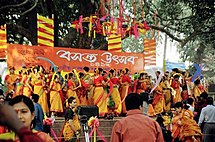Falgun
| Falgun | |
|---|---|
 Celebration stage of 1st day of Falgun, beginning of spring season in Bangladesh | |
| Native name | ফাল্গুন (Bengali) |
| Calendar | |
| Month number |
|
| Number of days | 29/30 |
| Season | Spring |
| Gregorian equivalent | February–March |
| Significant days | Chotiro 30 – Choitro Sankranti |
Falgun or Phalgun (Bengali: ফাল্গুন; Nepali: फाल्गुण) or Phagun (Assamese: ফাগুন) is the eleventh month of the year in the Bengali calendar,[1] the Assamese calendar,[2] and the Nepali calendar.[3] In the revision of the Bengali calendar used in Bangladesh since October 2019, the month has 29 days in common years or 30 in leap years of the Gregorian calendar.[4] In the previous version of the calendar, used in Bangladesh from 1987 through October 2019, Falgun had 30 days in common years or 31 days in leap years.[5] The month has 29 or 30 days, based on the true movements of the Sun, in the old non-reformed Bengali calendar, still used in West Bengal,[1] and in the Nepali calendar.[6]
Falgun was named for the nakshatra (lunar mansion) Uttara phalguni, in the vicinity of which the full moon appears at that time of the year.[7] It marks the arrival of spring, the sixth and final season in Bangladesh, West Bengal, Assam, and Nepal.[1] Falgun falls between mid-February and mid-March on the Gregorian calendar.[8]
Observances[edit]
- Falgun 1 - Pahela Falgun (Bangladesh)[9]
- Falgun 7 – Democracy Day (Nepal)[10]
- Falgun 8
- Language Martyrs' Day (Bangladesh)[4]
- International Mother Language Day (Bangladesh, India)[11]
- Falgun 12 – National Education Day (Nepal)[12]
- Falgun 14 – Maha Shivaratri (India, Nepal)[13]
- Falgun full moon – Dol Purnima (India), Holi (Bangladesh, India)[14]
See also[edit]
References[edit]
- ^ a b c Gyllenbok, Jan (2018). Encyclopaedia of Historical Metrology, Weights, and Measures. Vol. 1. Birkhäuser. pp. 260–261. ISBN 978-3-319-57596-4.
- ^ Gyllenbok, Jan (2018). Encyclopaedia of Historical Metrology, Weights, and Measures. Vol. 1. Birkhäuser. p. 252. ISBN 978-3-319-57596-4.
- ^ Crump, William D. (2014). Encyclopedia of New Year's Holidays Worldwide. McFarland. p. 38. ISBN 978-1-4766-0748-1.
- ^ a b "Bangladesh reworks Bangla calendar to match national days with West". bdnews24.com. 17 October 2019.
- ^ Chakrabarti, Kunal; Chakrabarti, Shubhra (2013). Historical dictionary of the Bengalis. Scarecrow Press. pp. 114–115. ISBN 978-0-8108-5334-8.
- ^ Crump, William D. (2014). Encyclopedia of New Year's Holidays Worldwide. McFarland. pp. 26–27. ISBN 978-1-4766-0748-1.
- ^ Jones, Howard D. (2018). "Historical Note: The Origin of the 28 Nakṣatras in Early Indian Astronomy and Astrology". Indian Journal of History of Science. 53 (3): 319. doi:10.16943/ijhs/2018/v53i3/49463. S2CID 134652511.
- ^ Nicholas, Ralph W. (2003). Fruits of Worship: Practical Religion in Bengal. New Delhi: Chronicle Books. p. 27. ISBN 978-81-8028-006-1.
- ^ "Pahela Falgun brings colour in life". The Daily Star. UNB. 13 February 2018.
- ^ "Two Tundikhel events". Nepali Times. 19 February 2021.
- ^ Tithila, Kohinur Khyum (22 October 2019). "Ashshin in 31 days in revised Bangla calendar". Dhaka Tribune.
- ^ Graner, Elvira (July 2006). "Education in Nepal: Meeting or Missing the Millennium Development Goals?". Contributions to Nepalese Studies. 33 (2): 153.
- ^ "Nepal celebrates Mahashivaratri festival". Xinhua News Agency. 20 February 2012.
- ^ MacDonald, Margaret Read, ed. (1992). The Folklore of World Holidays. Gale Research. pp. 144–145. ISBN 0-8103-7577-X.
External links[edit]
- "Bangabda". Banglapedia.
